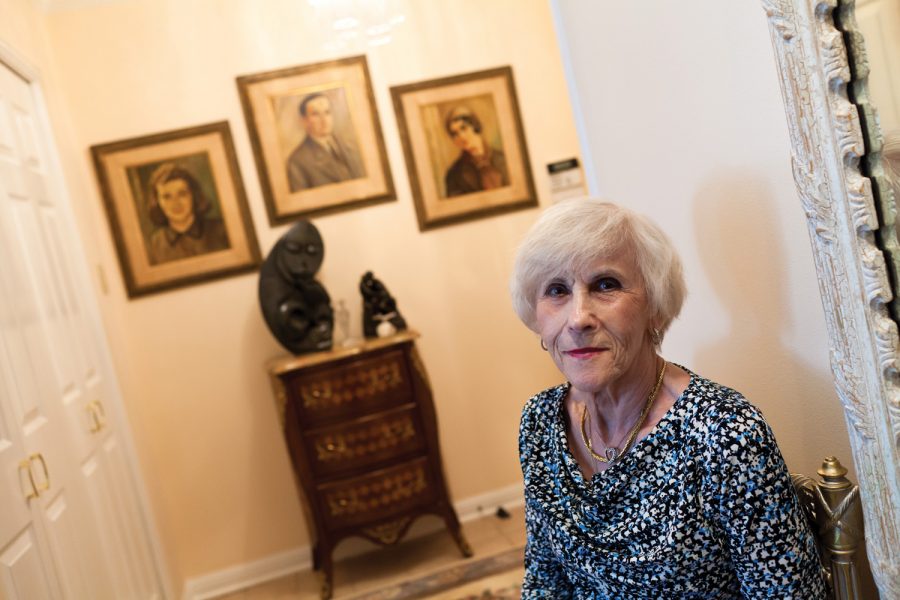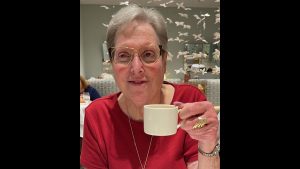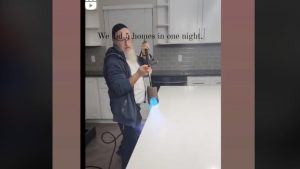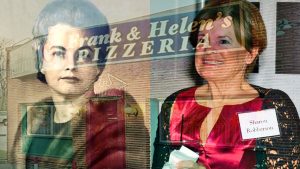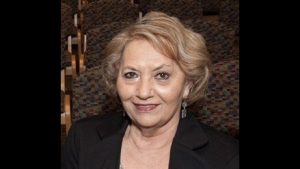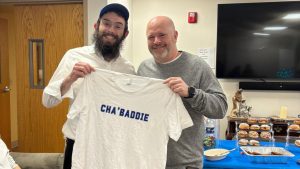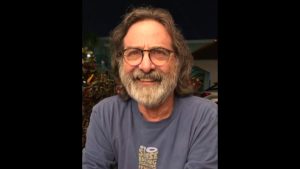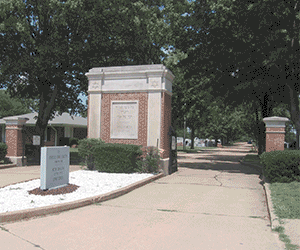Rachel Miller
Published May 22, 2013
Crossing a Paris street to go to a bakery, a young child was hit by a car driven by a Nazi. “It was like I was a piece of paper,” the French-born Rachel Goldman Miller recalls. “He never stopped.”
During the German occupation of France in World War II, her broken left ankle was scarcely a priority. Survival was.
In medical experiments and in concentration camps, Miller would lose both parents, her two brothers and her sister, all of whom had earlier fled anti-Semitism in Poland, leaving behind the family’s large home and servants.
During the war, a total of 93 of Miller’s relatives would die. For her own life — despite guilt that she “had not suffered enough” — she credits her mother.
What turned out to be three days before the Nazis rounded up the Goldmans in Paris, her mother sent 9-year-old Rachel, her youngest, to hide on a Catholic family’s farm. Miller would also stay in another family’s kitchen and a convent.
In the past 10 years, Rachel Miller has shared her wartime story with hundreds of schoolchildren and other visitors at the Holocaust Museum and Learning Center here. “Her ability to connect with students of all ages … is incredible,” says museum docent Irl Solomon.
“The students leave imbued with Elie Wiesel’s dictum: ‘To listen to a witness is to become a witness,’” he adds.
Yet for almost 50 years, Miller remained publicly silent about her experiences. “Many of us repressed our stories and just went on,” she says.
Steven Spielberg changed her mind. The director’s Academy Award-winning “Schindler’s List” (1993) chronicled the true story of Oskar Schindler, the Austrian industrialist who saved 1,100 mostly Polish Jews, employing them as workers in his factory.
While previous attempts to re-create the Holocaust on TV “didn’t look like reality,” Miller says, “Spielberg was instrumental in bringing back the Holocaust (to public view).” Watching the film compelled her to become one of the first Holocaust survivors to tell her story to Spielberg’s Shoah Foundation.
One aspect of Miller’s tale, revealed in growing depth only in recent years, concerns a Jewish soldier. Part of the American liberation force, he brought the orphaned Rachel to New York in 1946, but not before molesting her in France. The abuse continued in New York, where he took her to live with his wife and toddler daughter. “Every morning at 9:30, he would come into my bed,” Miller says.
When his wife found out, she threw out young Rachel. Years of therapy have helped convince Miller she was not to blame for her victimization. In sharing this part of her story with students, she often senses that others, too, have been molested.
After her speech, listeners sometimes cry. They want her to hug them. She does.
As a post-war teenager in New York, Miller would live in five different foster homes, all Jewish, after leaving the soldier’s. “The problem was with me,” she says. “I was extremely disturbed.”
Salvation arrived, however, when Milt Miller, a friend of one of the home’s residents, came to visit. “Milt was very, very cute. He was darling,” she says. Though she knew instantly she would marry him, they waited until she was 17 and had graduated from high school.
The Millers later relocated to Los Angeles, where they would raise their two sons. Both Rachel and Milt worked in retail. With her own war years an ever-more distant memory, she started a women’s auxiliary of the city’s Jewish War Veterans chapter and was elected both chapter and statewide president.
Unlike many Holocaust survivors, Miller had managed once as a child to return to her family’s two-room Paris apartment. Accompanied by an aunt and cousin, she had intended to retrieve a favorite doll. Instead, she grabbed the family photos that have remained some of her most cherished possessions. But in Los Angeles, there was little time or reason to dwell on loss.
Then, the unthinkable happened. Younger son Mark, an attorney for Warner Bros., died of AIDS in 1992. He was 35. The day he passed his bar exam, he had told his parents he was gay.
After Mark’s death, Milt’s diabetes worsened. He lost not only his eyesight, but also his will to live, Rachel Miller says.
Yet somehow, she was able to draw on the strength that helped her as a child. “I’ve been surviving and taking care of myself since I’m nine-years-old,” she says. The Millers’ other son, Neil, also a lawyer, had by this time moved here, where he is now assistant circuit attorney for the city of St. Louis.
The elder Millers visited regularly. Realizing that Los Angeles would never be the same, Rachel masterminded the couple’s move to St. Louis in 1993.
Mind you, she was getting around at this point in a wheelchair and on a motorized scooter. In 1986, she had tripped over a garden hose and re-broken her ankle, the same one injured by the Nazi and left to heal on its own. This time, Miller had surgery and a cast.
Afterward, her pain increased. The foot would swell and turn cold. Physical therapy accomplished nothing.
When doctors said she would never walk again, Milt was aghast. “Why don’t you break your ankle and start all over again?” he would say. She ignored it.
Milt passed away on Dec. 30, 1997, the same day, 56 years later, that her father had been murdered by German experimenting with various gases for later use in extermination camps.
Several years after Milt’s death, Miller accidentally re-broke her left ankle, this time when her scooter seat landed on her foot. Doctors put her ankle in a soft brace. Eight weeks later she was instructed to remove the brace for an hour, put it back in place for an hour and so on.
Her first time without the brace, she put her foot down and felt no pain. “I thought I was hallucinating,” she says. Eventually, she was walking, without a cane. On a visit to her husband’s gravesite, she confirmed the logic of his thinking.
After 11 years in a wheelchair, to walk again was “like a miracle,” she says. As if reborn, she returned to the retail business and presently works 15 to 20 hours weekly as a sales associate at Coldwater Creek women’s store in West County.
She also became a Holocaust Museum speaker here, finding the courage to lay bare “the still very raw wounds of her childhood,” says Marci Rosenberg, past president of the museum’s board of directors.
In addition, Miller began traveling unassisted. During a Jewish Federation mission to Israel, she learned from a St. Louis friend, Carol Hellman, who was then volunteering on an Israeli Defense Force military base, that IDF soldiers often lacked such personal necessities as toilet paper, toothpaste, soap, razors, food and transportation vouchers that would enable them, when on leave, to afford trips home to their families.
Reminded of the rationing and deprivation during her own childhood, Miller gathered several friends back in St. Louis. With them, she founded Shaving Israel in 2004. By the end of this year, Miller estimates that through fundraisers and donations, the non-profit will have raised $150,000.
Miller continues to live in a fashionable building of condos, the same building where she and Milt resided, but presently in a unit with far more sunlight. “I am quite happy here,” she says of her art-filled surroundings.
Snapshots with Milt, their sons and other relatives likewise command attention. Whether copied, enlarged and hanging on walls, or small and tucked into an album, many are the same photos a young Miller rescued from her family’s Paris apartment.
However, for Miller the three framed portraits in her entryway seem the most drenched in emotion. “They are my mother, my father and my sister,” she explains. Each portrait was painted on a potato sack in the mid-1940s and signed by “J. Lehmann,” a German prisoner of war then held in Langres, France.
The artist worked from snapshots that also included Miller’s two brothers, although Lehmann had time only to paint three family members. The photos were borrowed and later returned to Miller by a Jewish soldier.
Chillingly, this was the same soldier who brought Miller to New York. The portraits were his surprise gift for her 13th birthday. Miller has bequeathed them to the Holocaust Museum here.
Rachel Miller
AGE: 80
HOME: Chesterfield
FAMILY: Married for 47 years to the late Milt Miller, two sons: Neil (married to Marci Lifton) and the late Mark Miller, and two granddaughters
FUN FACT: “Beyond Me: A Song Cycle in the Key of Survival,” an original, one-woman, multi-media composition about Rachel Miller and her late son, Mark, will return to St. Louis on Nov. 17 for a performance at the Jewish Community Center.



